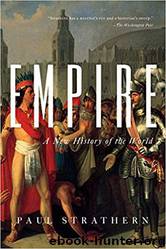Empire: A New History of the World by Paul Strathern

Author:Paul Strathern
Language: eng
Format: epub
Tags: Epub3
Publisher: Pegasus Books
Published: 0101-01-01T00:00:00+00:00
7
The Ottoman Empire
We now return to the region where the world’s earliest empires had begun – and thrived – for almost three millennia, namely the Middle East. The Ottoman Empire, which originated in 1299, would eventually achieve sovereignty over territory in Asia, Europe and Africa, and would last for over 600 years. On four remarkable occasions it would even threaten to destroy the more advanced civilisation of Europe. Just 150 years after the founding declaration of the Ottoman Empire, during its early expansionist phase, Sultan Mehmed II (usually known as ‘the Conqueror’) achieved the unthinkable feat of conquering Constantinople, the capital of the Byzantine Empire (still officially designated the ‘Roman and Byzantine Empire’).
At its height in the eleventh century, the Byzantine Empire had ruled over every country bordering on the Mediterranean, from Spain and Italy to Egypt and North Africa, as well as controlling the shores of the Black Sea and the upper half of the Red Sea. By 1453, Mehmed the Conqueror had all but destroyed this empire, taking Anatolia, Greece and moving up into the Balkans, in the process encircling Constantinople. After Mehmed the Conqueror entered the holy city, Constantine XI, the last man to claim the title of Roman Emperor, was killed.
The Ottoman sultan then declared that the 900-year-old Hagia Sofia (‘Holy Wisdom’ in Greek), Christendom’s holiest cathedral and the largest building in the world, would from now on become a mosque. He also pronounced himself ‘Kaysari-i-Rûm’ (Turkish for ‘Caesar of Rome’). From his vantage point on the Bosphorus, Mehmed the Conqueror’s capital straddled Europe and Asia, making it the potential capital of the world. (Just over three centuries later, when Napoleon took Egypt, harbouring similar illusions, he regarded Cairo as the most strategic city on earth, the hub of Europe, Asia and Africa; America was dismissed as a primitive outpost.)
Back in Rome, a succession of popes had desperately been attempting to rally the divided nations of European Christendom to restart the Crusades, and drive back the Ottomans. One by one these attempts foundered, owing to ineffectual leadership, internal jealousies, suspicions and so forth. Meanwhile the Ottoman advance continued inexorably north through the Balkans towards Venice, and in 1480 even established a foothold on the Italian peninsula at the southern port of Otranto. Here the local bishop was publicly sawed in half before the terrified population, 12.000 of whom were then put to the sword, with another 50.000 being shipped off into slavery.
Within weeks, the Ottoman forces had advanced 200 miles up the east coast. Less than 200 miles east across the Apennines, the ailing, ageing Pope Sixtus IV was at his wits’ end. It looked as if Rome was now to suffer the fate of Constantinople. Then, as if by a miracle, the Ottomans suddenly withdrew and sailed back across the Adriatic. In an echo of the Mongol invasion of Eastern Europe three centuries previously, the Ottomans had learned of the death of Mehmed the Conqueror, and were anxious to return to Constantinople where the future sultan would be chosen.
Download
This site does not store any files on its server. We only index and link to content provided by other sites. Please contact the content providers to delete copyright contents if any and email us, we'll remove relevant links or contents immediately.
| Africa | Americas |
| Arctic & Antarctica | Asia |
| Australia & Oceania | Europe |
| Middle East | Russia |
| United States | World |
| Ancient Civilizations | Military |
| Historical Study & Educational Resources |
The Daily Stoic by Holiday Ryan & Hanselman Stephen(3117)
The Fate of Rome: Climate, Disease, and the End of an Empire (The Princeton History of the Ancient World) by Kyle Harper(2884)
People of the Earth: An Introduction to World Prehistory by Dr. Brian Fagan & Nadia Durrani(2623)
Ancient Worlds by Michael Scott(2504)
Babylon's Ark by Lawrence Anthony(2438)
Foreign Devils on the Silk Road: The Search for the Lost Treasures of Central Asia by Peter Hopkirk(2393)
The Daily Stoic by Ryan Holiday & Stephen Hanselman(2357)
India's Ancient Past by R.S. Sharma(2308)
MOSES THE EGYPTIAN by Jan Assmann(2283)
The Complete Dead Sea Scrolls in English (7th Edition) (Penguin Classics) by Geza Vermes(2147)
Lost Technologies of Ancient Egypt by Christopher Dunn(2125)
The Earth Chronicles Handbook by Zecharia Sitchin(2106)
24 Hours in Ancient Rome by Philip Matyszak(1978)
Alexander the Great by Philip Freeman(1968)
Aztec by Gary Jennings(1884)
The Nine Waves of Creation by Carl Johan Calleman(1789)
Curse Tablets and Binding Spells from the Ancient World by Gager John G.;(1773)
Before Atlantis by Frank Joseph(1744)
Earthmare: The Lost Book of Wars by Cergat(1719)
